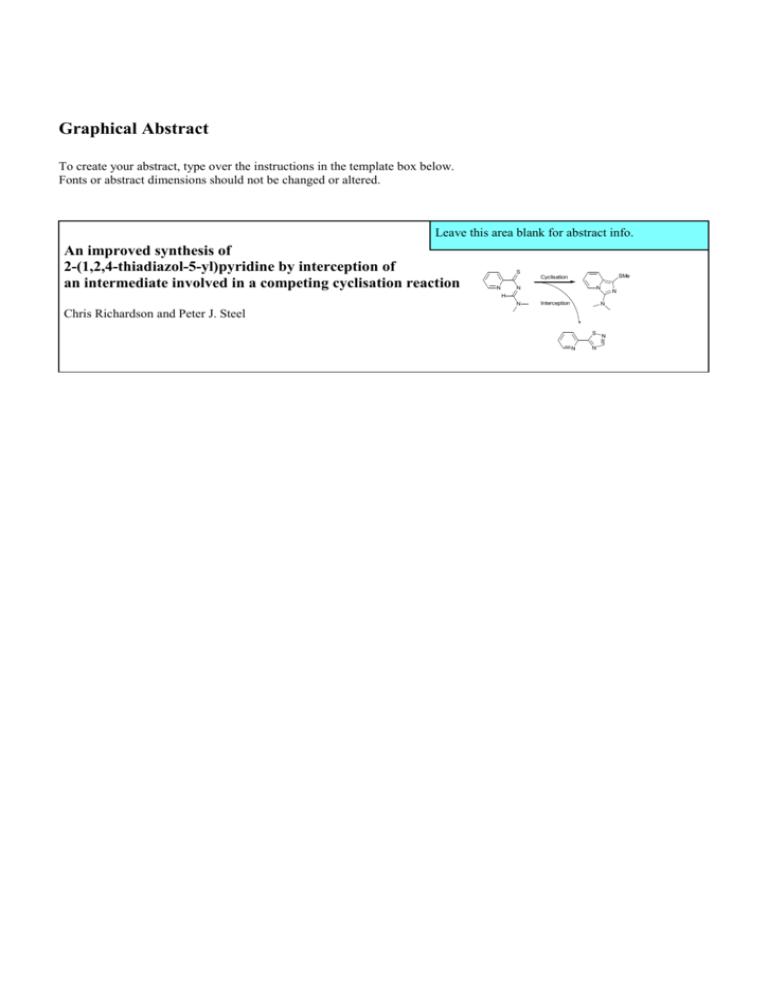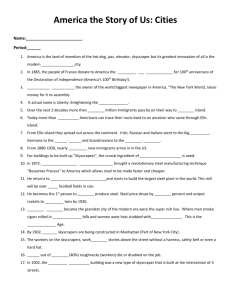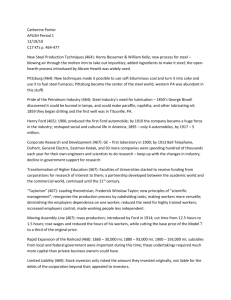
Graphical Abstract
To create your abstract, type over the instructions in the template box below.
Fonts or abstract dimensions should not be changed or altered.
Leave this area blank for abstract info.
An improved synthesis of
2-(1,2,4-thiadiazol-5-yl)pyridine by interception of
an intermediate involved in a competing cyclisation reaction
S
N
SMe
Cyclisation
N
N
N
H
N
Interception
N
Chris Richardson and Peter J. Steel
S
N
N
N
Tetrahedron Letters
TETRAHEDRON
LETTERS
Pergamon
An improved synthesis of 2-(1,2,4-thiadiazol-5-yl)pyridine by
interception of an intermediate involved in a competing
cyclisation reaction
Chris Richardson and Peter J. Steel*
Department of Chemistry, University of Canterbury, Christchurch, New Zealand
Abstract— Reaction of thiopicolinamide with N, N'-dimethylformamide dimethyl acetal leads to the formation of 3-(dimethylamino)-1methylthioimidazo[1,5-a]pyridine (3). However, the course of the reaction can be diverted to produce the title compound (1) in good yield
by timely interception of the intermediate thioacylamidine (2). © 2016 Elsevier Science. All rights reserved
For some time we have been interested in the synthesis and
study of new chelating N-heterocyclic ligands and their use
in coordination and metallosupramolecular chemistry.1 In
particular, we have focussed on the use of ligands
incorporating less commonly studied heterocyclic ring
systems, such as tetrazoles,2 1,2-benzisoxazoles,3 furoxans,4
benzotriazoles,5,6 1,4,2,5-dioxadiazines,7 thiazolo[5,4d]thiazoles,8 1,2,3-thia(and selena)diazoles,9 pyridazines,10
1,2,5-oxadiazoles and 1,2,5-thiadiazoles.11,12 We have been
particularly attracted to sulfur-containing azole ligands as
these seem to impart intriguing properties to the resultant
metal complexes.
Within this context, we identified 2-(1,2,4-thiadiazol-5yl)pyridine (1) (Scheme 1) as a potentially useful chelating
ligand and were surprised to find that the only literature
S
N
S
S-
(CH3)2NCH(OMe) 2
N
NH2
N
N
+
N
H
H
2
N
N
H2NOSO3H
S
N
N
1
N
SMe
N
N
N
3
Scheme 1. Synthesis of 1 and 3.
______________________
Keywords: N-ligand, 1,2,4-Thiadiazole, Imidazo[1,5-a]pyridine
Corresponding author: Tel.: +64-3-3642432; fax: +64-3-3642110;
email: peter.steel@canterbury.ac.nz
references to this compound relate to two reports of its use
as a ligand involved in ruthenium(II) complexes.13,14
Neither of these papers described experimental details of its
synthesis, other than a yield (32%), a melting point and an
oblique reference to the synthetic method, which cited a
two-step synthetic procedure employed by Lin et al.15 This
involved a process in which a thioamide was reacted with
N,N-dimethylformamide dimethylacetal to form a thioacyl
amidine
that
was
subsequently
reacted
with
hydroxylamine-O-sulfonic acid to furnish the thiadiazole
product. These authors15 reported the synthesis of the
isomeric 3- and 4-substituted pyridines, but not the 2substituted isomer.
When we attempted to employ this synthetic route we
found that reaction of thiopicolinamide with N,Ndimethylformamide dimethylacetal led to a different
product to the expected amidine (2). A high-resolution
mass spectrometry measurement provided a molecular
formula of C10H13N3S for the product and this was
supported by elemental analysis. The 1H-NMR spectrum
(Figure 1) clearly showed that this product has reduced
aromaticity of the pyridine ring, suggesting a 1,2-fused
pyrido subunit, and that it possessed dimethylamino and
methylthio substituents. Complete 1H- and 13C-NMR
assignments of this molecule were made, and by
comparison of the NMR data with a similar molecule
containing an imidazo[1,5-a]pyridine system,16 we
identified
the
product
as
3-(dimethylamino)-1methylthioimidazo[1,5-a]pyridine (3).17 We believe that
formation of this new compound is initiated by
intramolecular cyclisation of the pyridyl nitrogen onto the
amidine carbon of 2, a process not available to the 3- and 4pyridyl analogues (Scheme 1). Formation of imidazo[1,5a]pyridines by related cyclisations are known.18,19
1
Tetrahedron Letters
and a single compound was formed, the spectrum of which
was consistent with it being the desired amidine (2).
However, during the course of the next ninety minutes, this
compound underwent further reaction to generate a mixture
of compounds containing the rearranged product (3).
Figure 1. 1H-NMR spectrum of 3.
We felt that the course of the reaction could be intercepted
by simply carrying out the two steps without isolation of
the intermediate, conveniently turning the synthesis into a
'one-pot' procedure. Accordingly, thiopicolinamide and
N,N'-dimethylformamide dimethyl acetal were combined
and allowed to react for 30 minutes before hydroxylamineO-sulfonic acid and pyridine in a solvent mixture of
methanol/ethanol were added and the resulting mixture
allowed to react at room temperature. By this method (1)
was obtained in 75% yield after workup and purification, 20
a considerable improvement over the previously reported
yield of 32%.
We next decided to monitor the progress of this reaction by
1
H-NMR. We found that after combining the reactants for
30 minutes, the thiopicolinamide was completely consumed
Acknowledgements: We thank the Royal Society of New
Zealand for funding through the Marsden Fund and a James
Cook Research Fellowship.
References and notes
118.09 (C8), 118.48 (C7), 119.00 (C1), 120.69 (C5), 129.94
(C8a), 144.39 (C3). HRMS+ calc. m/z for C10H13N3S
207.0830; found 207.0830. EIMS+ m/z 207.1 (M+, 100%),
192.0 (M+-CH2, 55%), 78.0 (Py+, 29%).
18. D'Anello, M.; Erba, E.; Gelmi, M. L.; Pocar, D. Chem. Ber.,
1988, 121, 67-73.
19. Donovan, R. J.; Morgan, R. J. U.S. Patent 5,969,150, 1999.
20. Preparation of (1): Thiopicolinamide (0.50 g, 3.6 mmol) and
dimethylformamide dimethyl acetal (0.48 mL, 3.6 mmol)
were combined and allowed to stand for 30 minutes. A
solution made of hydroxylamine-O-sulfonic acid (0.49 g, 4.3
mmol) in MeOH (3 mL) and then pyridine (0.58 mL, 7.5
mmol) in EtOH (5 mL) was then added and the solution was
stirred magnetically at RT for 5 h. The volatiles were then
removed in vacuo and the residue taken up in CH2Cl2 (25
mL) and washed with H2O (1 x 10 mL), 0.1 N NaOH (1 x 10
mL), H2O (1 x 10 mL), dried over Na2SO4 and concentrated
to dryness by rotary evaporation. The residue was
chromatographed on silica gel eluting with EtOAc–Pet. ether
(1–5) and the product (Rf 0.37) was obtained as a canaryyellow solid (0.44 g, 75%). mp 73–75°C (lit.14 68–69C)
(Found: C, 51.56; H, 3.08; N, 25.57; S, 19.92. C7H5N3S
requires C, 51.52; H, 3.09; N, 25.75; S, 19.65). 1H-NMR (300
MHz, CDCl3)
J = 7.32, 4.88, 1.47 Hz,
H5), 7.88 (1H, td, J = 7.32, 1.47 Hz, H4), 8.18 (1H, d, J =
7.81 Hz, H3), 8.66 (1H, d, J = 4.39 Hz, H6), 8.75 (1H, s,
H3'); 13C-NMR (protonated carbons only) (75 MHz, CDCl3)
120.38 (C3), 126.21 (C5), 137.51 (C4), 149.99 (C6),
163.50 (C3'). HRMS+ calc. m/z for C7H5N3S 163.0204; found
163.0200. EIMS+ m/z 163.0 (M+, 100%), 136.0 (M+-CNH,
43%), 104.0 (PyCN+, 53%), 78.0 (Py+, 26%), 59 (SCNH+,
17%).
1. Steel, P. J. Acc. Chem. Res. 2005, 38, 243-250.
2. Downard, A. J.; Steel P. J.; Steenwijk, J. Aust. J. Chem. 1995
48, 1625-1642.
3. Richardson, C.; Steel, P. J. Inorg. Chem. Commun. 2000, 3,
155-158.
4. Richardson, C.; Steel, P. J. Aust. J. Chem. 2000, 53, 93-97.
5. Richardson, C.; Steel, P. J. Dalton Trans. 2003, 992-1000.
6. Borsting P.; Steel, P. J. Eur. J. Inorg. Chem. 2004, 376-380.
7. Richardson, C.; Steel, P. J. Eur. J. Inorg. Chem. 2003, 405408.
8. Zampese, J. A.; Keene, F. R.; Steel, P. J. Dalton Trans. 2004,
4124-4129.
9. Richardson, C.; Steel, P. J. Aust. J. Chem. 2002, 55, 783-788.
10. Sumby, C. J.; Steel, P. J. Inorg. Chem. Commun. 2003, 6,
127-130.
11. Richardson, C.; Steel, P. J. Acta Crystallogr. 2001, C57, 197198.
12. Richardson, C.; Steel, P. J.; D'Alessandro, D. M.; Junk, P. C.;
Keene, F. R. J. Chem. Soc., Dalton Trans. 2002, 2775-2785.
13. Orellana, G.; Quiroga, M. L.; Braun, A. M. Helv. Chim. Acta
1987, 70, 2073-2086.
14. Orellana, G.; Alvarez-Ibarra, C.; Quiroga, M. L. Bull. Soc.
Chim. Belg. 1988, 97, 731-741.
15. Lin, Y.-I.; Lang, S. A., Jr.; Petty, S. R. J. Org. Chem. 1980,
45, 3750-3753.
16. Katritzky, A. R.; Cobo-Domingo, J.; Yang, B.; Steel, P. J.
Tetrahedron Asymmetry, 1999, 10, 255-263.
17. Preparation of (3): Thiopicolinamide (0.50 g, 3.6 mmol) and
dimethylformamide dimethyl acetal (0.58 mL, 3.6 mmol)
were combined and left to stand at RT for 4 d. The methanol
produced was removed in vacuo, and the residue
chromatographed on silica gel with EtOAc–Pet. ether (1–4) as
eluant giving the product (Rf 0.18) as a yellow solid (0.40 g,
54%). mp 34–37°C (Found: C, 57.72; H, 6.41; N, 20.33; S,
15.72. C10H13N3S requires C, 57.95; H, 6.22; N, 20.26; S,
15.47). 1H-NMR (300 MHz, CDCl3) 2.38 (3H, s, -SMe),
2.87 (6H, s, -NMe2), 6.48 (1H, ddd, J = 7.3, 6.3 1.2 Hz, H6),
6.65 (1H, ddd, J = 9.3, 6.3, 1.0 Hz, H7), 7.47 (1H, dt, J = 9.3,
1.2 Hz, H8), 7.67 (1H, dt, J = 7.3, 1.0 Hz, H5); 13C-NMR (75
MHz, CDCl3) 20.10 (-SMe), 42.18 (-NMe2), 111.75 (C6),
2







